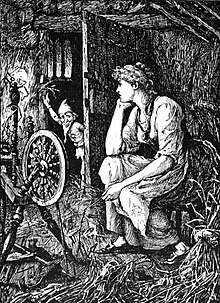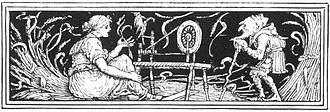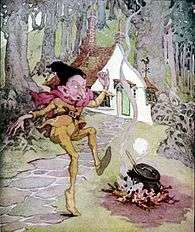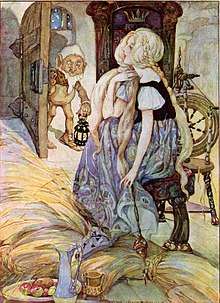Rumpelstiltskin
"Rumpelstiltskin" (/ˌrʌmpəlˈstɪltskɪn/ RUMP-əl-STILT-skin[1]) is a fairy tale popularly associated with Germany (where it is known as Rumpelstilzchen). The tale was one collected by the Brothers Grimm in the 1812 edition of Children's and Household Tales. According to researchers at Durham University and the NOVA University Lisbon, the story originated around 4,000 years ago.[2][3] However, many biases led some to take the results of this study with caution.[4]
| Rumpelstiltskin | |
|---|---|
 Illustration from Andrew Lang's The Blue Fairy Book (1889) | |
| Folk tale | |
| Name | Rumpelstiltskin |
| Also known as |
|
| Data | |
| Country |
|
| Published in |
|
Plot
In order to appear superior, a miller lies to the king, telling him that his daughter can spin straw into gold (some versions make the miller's daughter blonde and describe the "straw-into-gold" claim as a careless boast the miller makes about the way his daughter's straw-like blond hair takes on a gold-like lustre when sunshine strikes it). The king calls for the girl, shuts her in a tower room filled with straw and a spinning wheel, and demands she spin the straw into gold by morning or he will cut off her head (other versions have the king threatening to lock her up in a dungeon forever). When she has given up all hope, an imp-like creature appears in the room and spins the straw into gold in return for her necklace (since he only comes to people seeking a deal/trade). When next morning the king takes the girl to a larger room filled with straw to repeat the feat, the imp once again spins, in return for the girl's ring. On the third day, when the girl has been taken to an even larger room filled with straw and told by the king that he will marry her if she can fill this room with gold or execute her if she cannot, the girl has nothing left with which she can pay the strange creature. He extracts from her a promise that she will give him her firstborn child, and so he spins the straw into gold a final time. (In some versions, the imp appears and begins to turn the straw into gold, paying no heed to the girl's protests that she has nothing to pay him with; when he finishes the task, he states that the price is her first child, and the horrified girl objects because she never agreed to this arrangement.)
The king keeps his promise to marry the miller's daughter, but when their first child is born, the imp returns to claim his payment: "Now give me what you promised." She offers him all the wealth she has to keep the child, but the imp has no interest in her riches.
He finally consents to give up his claim to the child if she can guess his name within three days (some versions have the imp limiting the number of daily guesses to three and hence the total number of guesses allowed to a maximum of nine).
Her many guesses fail, but before the final night, she wanders into the woods (in some versions, she sends a servant into the woods instead of going herself, in order to keep the king's suspicions at bay) searching for him and comes across his remote mountain cottage and watches, unseen, as he hops about his fire and sings. In his song's lyrics— "tonight tonight, my plans I make, tomorrow tomorrow, the baby I take. The queen will never win the game, for Rumpelstiltskin is my name"— he reveals his name.
When the imp comes to the queen on the third day, after first feigning ignorance, she reveals his name, Rumpelstiltskin, and he loses his temper and their bargain. Versions vary about whether he accuses the devil or witches of having revealed his name to the queen. In the 1812 edition of the Brothers Grimm tales, Rumpelstiltskin then "ran away angrily, and never came back." The ending was revised in an 1857 edition to a more gruesome ending wherein Rumpelstiltskin "in his rage drove his right foot so far into the ground that it sank in up to his waist; then in a passion he seized the left foot with both hands and tore himself in two." Other versions have Rumpelstiltskin driving his right foot so far into the ground that he creates a chasm and falls into it, never to be seen again. In the oral version originally collected by the Brothers Grimm, Rumpelstiltskin flies out of the window on a cooking ladle.
Variants
_1976%2C_MiNr_Kleinbogen_2187-2192.jpg)
The same story pattern appears in numerous other cultures: Tom Tit Tot in England (from English Fairy Tales, 1890, by Joseph Jacobs); The Lazy Beauty and her Aunts in Ireland (from The Fireside Stories of Ireland, 1870 by Patrick Kennedy); Whuppity Stoorie in Scotland (from Robert Chambers's Popular Rhymes of Scotland, 1826); Gilitrutt in Iceland; جعيدان (Joaidane "He who talks too much") in Arabic; Хламушка (Khlamushka "Junker") in Russia; Rumplcimprcampr, Rampelník or Martin Zvonek in the Czech Republic; Martinko Klingáč in Slovakia; "Cvilidreta" in Croatia; Ruidoquedito ("Little noise") in South America; Pancimanci in Hungary (from A Csodafurulya, 1955, by Emil Kolozsvári Grandpierre, based on the 19th century folktale collection by László Arany); Daiku to Oniroku (大工と鬼六 "A carpenter and the ogre") in Japan and Myrmidon in France.
An earlier literary variant in French was penned by Mme. L'Héritier, titled Ricdin-Ricdon.[5] A version of it exists in the compilation Le Cabinet des Fées, Vol. XII. pp. 125-131.
The Cornish tale of Duffy and the Devil plays out an essentially similar plot featuring a "devil" named Terry-top.
All these tales are Aarne–Thompson type 500, "The Name of the Helper".[6]
Name origins

The name Rumpelstilzchen in German means literally "little rattle stilt", a stilt being a post or pole that provides support for a structure. A rumpelstilt or rumpelstilz was consequently the name of a type of goblin, also called a pophart or poppart, that makes noises by rattling posts and rapping on planks. The meaning is similar to rumpelgeist ("rattle ghost") or poltergeist, a mischievous spirit that clatters and moves household objects. (Other related concepts are mummarts or boggarts and hobs, which are mischievous household spirits that disguise themselves.) The ending -chen is a German diminutive cognate to English -kin.
The earliest known mention of Rumpelstiltskin occurs in Johann Fischart's Geschichtklitterung, or Gargantua of 1577 (a loose adaptation of Rabelais' Gargantua and Pantagruel) which refers to an "amusement" for children, i.e. a children's game named "Rumpele stilt oder der Poppart".[7]
Names used in translations
_(14750176241).jpg)
Translations of the original Grimm fairy tale (KHM 55) into various languages have generally substituted different names for the dwarf whose name is Rumpelstilzchen. For some languages, a name was chosen that comes close in sound to the German name: Rumpelstiltskin or Rumplestiltskin in English, Repelsteeltje in Dutch, Rumpelstichen in Brazilian Portuguese, Rumpelstinski or Rumpelestíjeles in Spanish, Rumplcimprcampr or Rampelník in Czech. In Japanese it is called ルンペルシュティルツキン (Runperushutirutsukin). Russian might have the most accomplished imitation of the German name with Румпельшти́льцхен (Rumpelʹštílʹcxen).
In other languages the name was translated in a poetic and approximate way. Thus Rumpelstilzchen is known as Päronskaft (literally "Pear-stalk") in Swedish,[8] where the sense of stilt or stalk of the second part is retained.
Slovak translations use Martinko Klingáč. Polish translations use Titelitury (or Rumpelsztyk) and Finnish ones Tittelintuure, Rompanruoja or Hopskukkeli. Serbian, Bosnian and Croatian Cvilidreta ("Whine-screamer"). The Slovenian translation uses "Špicparkeljc" (pointy-hoof). For Hebrew the poet Avraham Shlonsky composed the name עוץ לי גוץ לי (Ootz-li Gootz-li, a compact and rhymy touch to the original sentence and meaning of the story, "My adviser my midget"), when using the fairy tale as the basis of a children's musical, now a classic among Hebrew children's plays. Greek translations have used Ρουμπελστίλτσκιν (from the English) or Κουτσοκαλιγέρης (Koutsokaliyéris) which could figure as a Greek surname, formed with the particle κούτσο- (koútso- "limping"), and is perhaps derived from the Hebrew name. Urdu versions of the tale used the name Tees Mar Khan for the imp.
Psychology
- The value and power of using personal names and titles is well established in psychology, management, teaching and trial law. It is often referred to as the "Rumpelstiltskin Principle".
- Brodsky, Stanley (2013). "The Rumpelstiltskin Principle". APA PsycNET. American Psychological Association.
- Winston, Patrick (2009-08-16). "The Rumpelstiltskin Principle". M.I.T. Edu.
- van Tilburg, Willem (1972). "Rumpelstiltskin: The magic of the right word". Academia. Cite journal requires
|journal=(help)
References
- Wells, John (3 April 2008). Longman Pronunciation Dictionary (3rd ed.). Pearson Longman. ISBN 978-1-4058-8118-0.
- BBC (2016-01-20). "Fairy tale origins thousands of years old, researchers say". BBC. Retrieved 20 January 2016.
- Sara Graça da Silva, Jamshid J. Tehrani (January 2016). "Comparative phylogenetic analyses uncover the ancient roots of Indo-European folktales". Royal Society Open Science. 3 (1): 150645. doi:10.1098/rsos.150645. PMC 4736946. PMID 26909191.
- Julien d'Huy, Jean-Loïc Le Quellec, Yuri Berezkin, Patrice Lajoye and Hans-Jörg Uther 2017. Letter: Studying folktale diffusion needs unbiased dataset. Proceedings of the National Academy of Sciences, www.pnas.org/cgi/doi/10.1073/pnas.1714884114, or here; Julien d'Huy and Yuri Berezkin 2017. How Did the First Humans Perceive the Starry Night? On the Pleiades. The Retrospective Methods Network Newsletter, 12-13, p.113 or here
- Mlle L'HÉRITIER. La Tour ténébreuse et les Jours lumineux: Contes Anglois. 1705.
- "Name of the Helper". D. L. Ashliman. Retrieved 2015-11-29.
- Wiktionary article on Rumpelstilzchen.
- Grimm, Jacob; Grimm, Wilhelm (2008). Bröderna Grimms sagovärld (in Swedish). Bonnier Carlsen. p. 72. ISBN 978-91-638-2435-7.
Selected bibliography
- Bergler, Edmund (1961). "The Clinical Importance of "Rumpelstiltskin" As Anti-Male Manifesto". American Imago. 18 (1): 65–70. ISSN 0065-860X. JSTOR 26301733.
- Marshall, Howard W. (1973). "'Tom Tit Tot'. A Comparative Essay on Aarne-Thompson Type 500. The Name of the Helper". Folklore. 84 (1): 51–57. doi:10.1080/0015587X.1973.9716495. ISSN 0015-587X. JSTOR 1260436.
- Ní Dhuibhne, Éilis (2012). "The Name of the Helper: "Kinder- und Hausmärchen" and Ireland". Béaloideas. 80: 1–22. ISSN 0332-270X. JSTOR 24862867.
- Rand, Harry (2000). "Who was Rupelstiltskin?". The International Journal of Psychoanalysis. 81 (5): 943–962. doi:10.1516/0020757001600309. PMID 11109578.
- von Sydow, Carl W. (1909). Två spinnsagor: en studie i jämförande folksagoforskning (in Swedish). Stockholm: P.A. Norstedt. [Analysis of Aarne-Thompson-Uther tale types 500 and 501]
- Yolen, Jane (1993). "Foreword: The Rumpelstiltskin Factor". Journal of the Fantastic in the Arts. 5 (2 (18)): 11–13. ISSN 0897-0521. JSTOR 43308148.
- Zipes, Jack (1993). "Spinning with Fate: Rumpelstiltskin and the Decline of Female Productivity". Western Folklore. 52 (1): 43–60. doi:10.2307/1499492. ISSN 0043-373X. JSTOR 1499492.
- T., A. W.; Clodd, Edward (1889). "The Philosophy of Rumpelstilt-Skin". The Folk-Lore Journal. 7 (2): 135–163. ISSN 1744-2524. JSTOR 1252656.
Further reading
- Cambon, Fernand (1976). "La fileuse. Remarques psychanalytiques sur le motif de la " fileuse " et du " filage " dans quelques poèmes et contes allemands". Littérature. 23 (3): 56–74. doi:10.3406/litt.1976.1122.
External links
| Wikimedia Commons has media related to Rumpelstiltskin. |


- Free version of translation of "Household Tales" by Brothers Grimm from Project Gutenberg
- 'Tom Tit Tot: an essay on savage philosophy in folk-tale' by Edward Clodd (1898)
- Parallel German-English text in ParallelBook format
- 1985 TV movie

